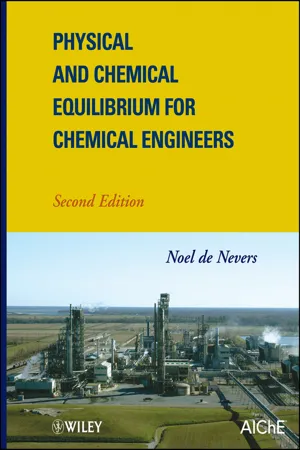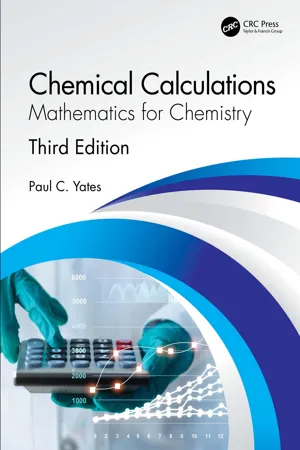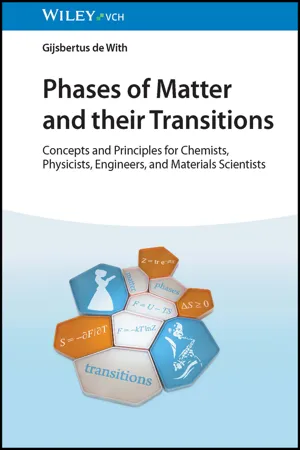Technology & Engineering
Clausius Clapeyron Equation
The Clausius-Clapeyron equation is a thermodynamic equation that relates the vapor pressure of a liquid to its temperature. It is used to predict the behavior of substances undergoing a phase change, such as boiling or condensation. The equation is important in fields such as chemistry, meteorology, and materials science.
Written by Perlego with AI-assistance
Related key terms
Related key terms
1 of 4
Related key terms
1 of 3
4 Key excerpts on "Clausius Clapeyron Equation"
- Noel de Nevers(Author)
- 2012(Publication Date)
- Wiley(Publisher)
(2) .(5.2)So for this change(5.3)Using the derivatives in Eq. 4.33 we can write(5.4)Factoring gives(5.5)This is the Clapeyron equation, which is rigorously correct for any phase change of a single pure chemical species. All of the curves in Figures 1.7 , 1.8 , 1.9 , and 5.2 agree with the Clapeyron equation. If your experimental data do not agree with it, then you have made an experimental error!Example 5.1 Compute the value of dP/dT for the steam– water equilibrium at 212°F using the Clapeyron equation, and compare it with the value in the steam table [5].From the steam table, we have , , and . Thus,(5.A)Using the nearest adjacent steam table entries for vapor pressure, we have(5.B)As in Example 4.1, this agreement does not demonstrate the correctness of the Clapeyron equation; the authors of the steam tables used the Clapeyron equation in making up that table. (If the values did not agree, it would show an error in the steam table!) In the Clapeyron equation we normally use P for pressure, because the Clapeyron equation applies to any equilibrium between any two phases of the same pure substance. If one of the phases is a gas or vapor, then the (dP/dT ) relation is a vapor-pressure curve, and we normally use p for vapor pressure, so the above derivatives would be written as dp/dT . This distinction is not very important, but the use of P for pressure in general and p for vapor pressure is common.5.4 The Clausius–Clapeyron EquationThe Clapeyron equation is rigorous and exact . It applies not only to gas–liquid equilibrium, but to any two-phase equilibrium of a pure species (e.g., liquid–solid, gas–solid) or change between two different crystal forms (e.g., graphite to diamonds, see Example 4.2). By adding some simplifications, we find the Clausius–Clapeyron (C-C) equation, which is only approximate but is a surprisingly good- eBook - ePub
General Physics
Mechanics and Molecular Physics
- L D Landau(Author)
- 2013(Publication Date)
- Pergamon(Publisher)
dT is the temperature difference between the two isotherms. Thus we haveFIG. 84or(d p =)V 2−V 1q 12d T / T=d pd T.q 12T()V 2−V 1This formula, which determines the slope of the phase-equilibrium curve p = p (T ), is called the Clausius–Clapeyron equation . It may also be written in the form=d Td p,T()V 2−V 1q 12where the temperature of the transition is regarded as a function of pressure. In these formulae the volumes V 1 , V 2 of the two phases and the heat q 12 relate to a given quantity of the substance (e.g. one gram or one gram-molecule).It should be noted that the derivative dp /dT is inversely proportional to the difference in volume V 2 – V 1 . Since the change in volume in evaporation is large and that in melting is small, melting curves are much steeper than evaporation curves. For example, to lower the boiling point of water by 1° it is sufficient to reduce the pressure by 27 mm Hg, whereas the same change in the melting point of ice would require the pressure to be increased by 130 atm.§68. Evaporation
A vapour in equilibrium with its liquid is said to be saturated , and its pressure is called the saturated vapour pressure . The liquid–vapour equilibrium curve (Fig. 81 , §66 ) may also be regarded as showing the relation between this pressure and the temperature.The saturated vapour pressure always increases with increasing temperature. We have seen above that this behaviour is due to the increase in volume of a substance on evaporation. This increase is usually very large. For example, the volume of water vapour at 100°C is 1600 times the volume of water; the boiling of liquid oxygen at −183°C is accompanied by a volume increase by a factor of about 300. - eBook - ePub
Chemical Calculations
Mathematics for Chemistry, Third Edition
- Paul C. Yates(Author)
- 2023(Publication Date)
- CRC Press(Publisher)
equation. C p (298 K) = 22. 13 J K − 1 mol − 1 + (1. 172 × 10 – 2 J K – 2 mol − 1 × 298 K) + (9.6 × 10 4 J K mol − 1) (298 K) 2 = 22. 13 J K − 1 mol − 1 + 3. 492 J K − 1 mol − 1 + 1. 081 J K − 1 mol − 1[--=P. LGO-SEPARATOR=--]= (22. 13 + 3. 492 + 1. 081) J K − 1 mol − 1 = 26.70 J K − 1 mol − 1 3.5 Clapeyron Equation There is a certain amount of vapour above every solid and liquid and if this is not free to escape, as in a closed vessel, equilibrium will be reached so that as many molecules leave the surface as re-enter. At this equilibrium, the pressure above the solid or liquid is known as the vapour pressure. A study of vapour pressure is important because it can provide us with information about the solid or liquid. The Clapeyron equation applies to any phase transition of a pure substance and is expressed by the equation d p d T = Δ t H T Δ t V where Δ t H and Δ t V are the enthalpy and volume changes respectively which accompany a phase transition t at absolute temperature T. The left-hand side introduces a notation that we have not met before; it needs to be treated as a complete quantity and the letter d, on its own, has no meaning in this equation. The quantity d p d T is called the derivative of p with respect to T. As we will see below, this function is equal to the gradient of the tangent of the graph of p against T. The graph of pressure against temperature for a substance is known as its phase diagram and can be used to indicate where a solid, liquid or gas will be found for given values of these variables. A typical one-component phase diagram is shown in Figure 3.3. FIGURE 3.3 A typical phase diagram. 3.5.1 Differentiation lf we consider a function such as f (x) = 3 x 2 + 1 whose graph is shown in Figure 2.4, we can calculate an average rate of change between any two values of x, such as x = 1 and x = 5 - eBook - ePub
Phases of Matter and their Transitions
Concepts and Principles for Chemists, Physicists, Engineers, and Materials Scientists
- Gijsbertus de With(Author)
- 2023(Publication Date)
- Wiley-VCH(Publisher)
Metastable states can occur for the range ab (supersaturation) and de (superheating), while the range bcd represents unstable states. For the van der Waals equation of state (vdW EoS ), a parametric solution linking ρL and ρV exists [3] . The Clapeyron equation evidently can be applied to solid–solid and solid–liquid transitions as well.When the phase transition of a substance is between the gas phase and a condensed phase (C) and occurs at T ≪ Tcri of that substance, the specific volume of the gas phase VG is much larger than that of the condensed phase VC . Therefore, one may approximate ΔV = VGC = VG (1 − VC /VG ) by VG . For sufficiently low pressure the perfect gas law can be invoked so that VG = RT/P with R, as usual, the gas constant. Inserting in the Clapeyron equation leads to the Clapeyron–Clausius equation:(12.7)We deal with the Clapeyron–Clausius equation further in Section 13.1 .12.3 The Mosselman Solution for the Clapeyron Equation
The Clapeyron equation is not an exact differential equation, and in order to arrive at an explicit relation between the pressure P and temperature T, one has to integrate the equation. Because the enthalpy and volume changes involved are both functions of T and P, this cannot be done directly. It is generally believed that the Clapeyron equation is unsolvable without preliminary substitution of a simple expression for ΔH(T) and ΔV(T). However, Mosselman et al. [4] found the integration factor ΔV/T
Index pages curate the most relevant extracts from our library of academic textbooks. They’ve been created using an in-house natural language model (NLM), each adding context and meaning to key research topics.
Explore more topic indexes
Explore more topic indexes
1 of 6
Explore more topic indexes
1 of 4



